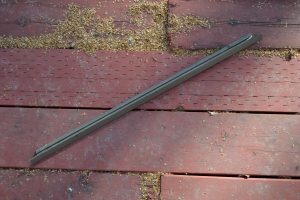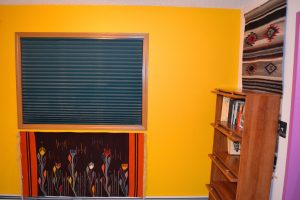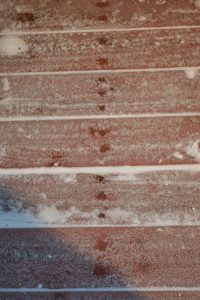(Or “Another blog post for insomniacs.”)
While we spend a lot of time and money working to keep the house heated each day from about mid-September through early May, if you only focus on that you miss some other interesting things that work more subtly on longer cycles.
One Sunday morning in early spring, Rose and I were sitting in the living room reading the newspaper. It was very quiet. The snow had melted, it had yet to green up, and few birds were back. We’d been too lazy to put on music, so it was quiet inside, too. We heard something fall with a clatter to the deck. Surprised, we got up and looked out the window to see a strange piece of metal lying there.
We didn’t have a clue what it might be. Metal doesn’t usually fall from the sky in our neighborhood. We went out to take a closer look at it. It was a window clip – a piece of metal inserted between the window glass and its wooden frame to keep the glass in place. Our windows are triple-glazed, so these clips are doing some important work, holding up a lot of glass. Apparently, over the course of thirty years of warming and cooling (daily and seasonal), this clip from an upstairs window had worked its way loose and decided to finally take the leap for freedom on this fine Sunday morning. I think this was our first discovery of decadal thermal reactions in our house.
The second happened just last month, when we decided to paint an accent wall in the master bedroom. For many years, I would wake up in the morning and stare at the ceiling and wonder how I had done such a poor job painting the ceiling. And it seemed to be getting worse as time passed. It was like I had short-changed the edge a little after each “swath” had been covered, creating little gray triangles at the ceiling’s edge along the outer wall. So when we decided to paint the accent wall, I decided that this would also be a good time to hit that ceiling again and finally clean up my mess.
As we prepped, I took a closer look at things and found that these swaths were remarkably regular in their spacing. I’m not a machine, so that was suspicious. Then I noticed that I could see where the nailheads in the outer wall lay under the joint compound and paint: each one was highlighted in gray. I wet my finger and rubbed – and the gray came away. The ceiling is “popcorn” style, so I couldn’t just wipe its gray wedges away, but somehow on the upper corner of the house, the ceiling joist-ends and the nails in the outer wall create enough of a thermal differential on the interior surface to either catch dust or grow a light coat of mold over about 20 years. It’s hard to see – the light has to be just right – but at least now I don’t berate my painting skills anymore. Rose’s are of course excellent. The newly painted wall and ceiling look great!
There are other thermal oddities that occur on shorter timeframes. The nails holding the deck planking down gradually pull themselves up out of their snug holes and can hurt your feet if you don’t bang them back down every spring. I’ve taken to using twisted nails in deck repair; they resist thermal uprising. A couple of weeks ago I was reminded of this when I saw how strangely the night’s hoarfrost had grown on the deck, with each nailhead in the clear while the surrounding wood had a hoary coat.
I am sure we will eventually find something else to add to this list.




Love the accent color!
Rose makes good choices.